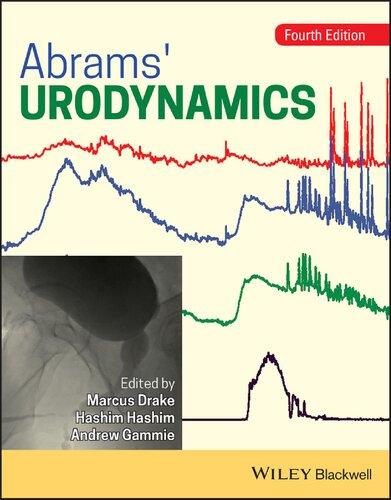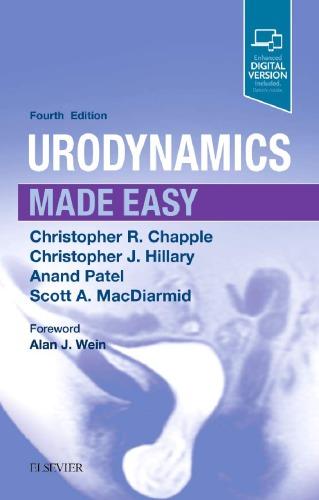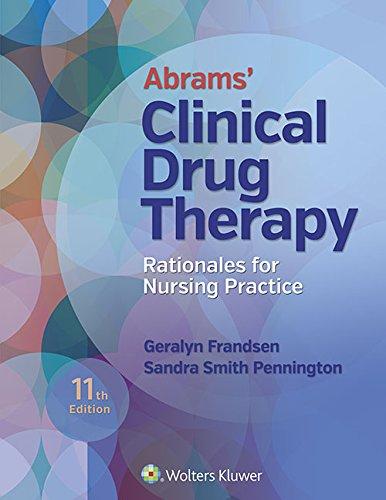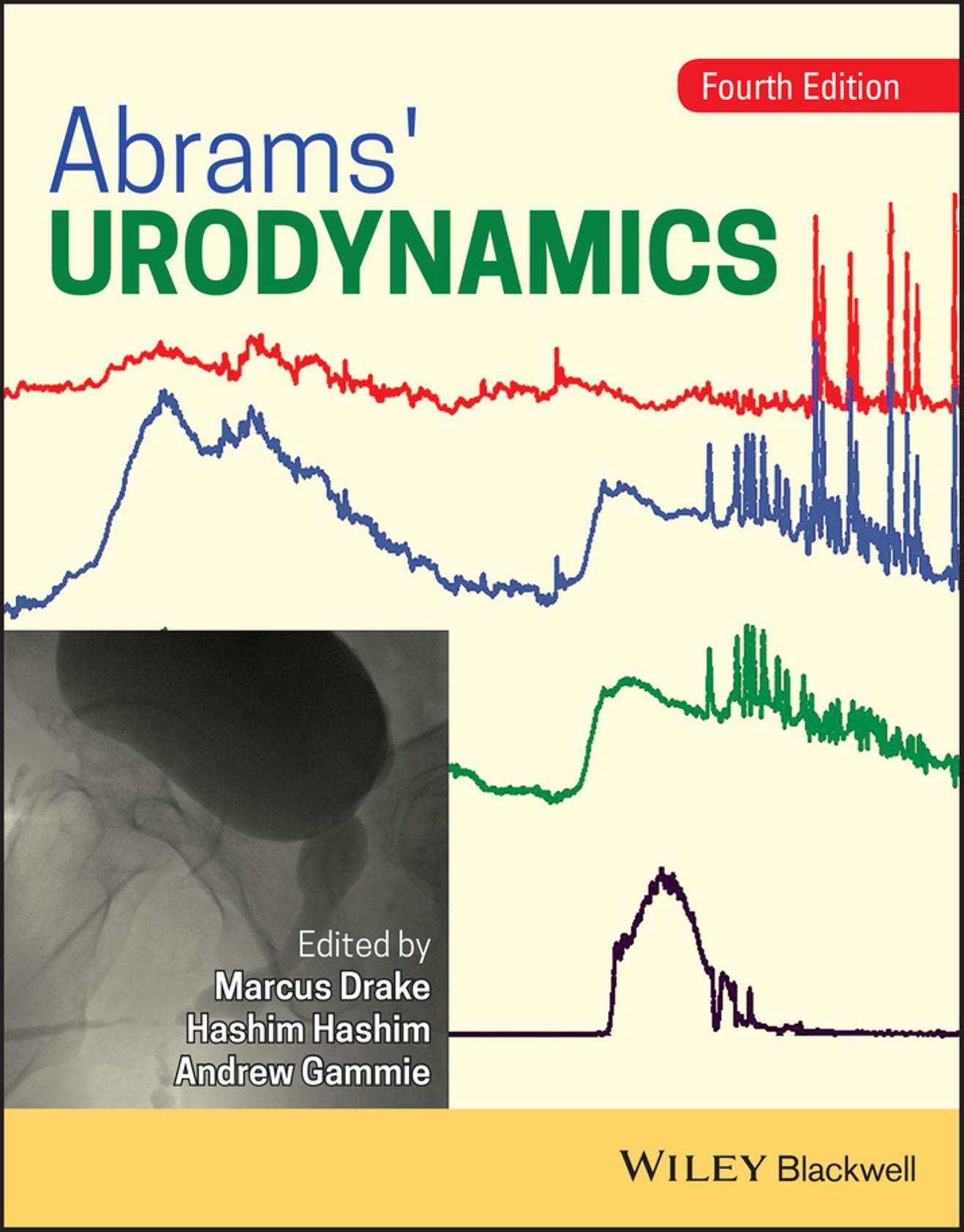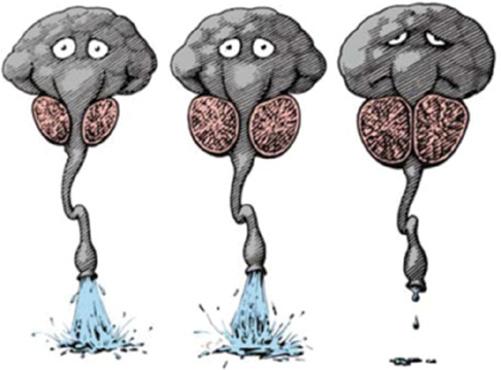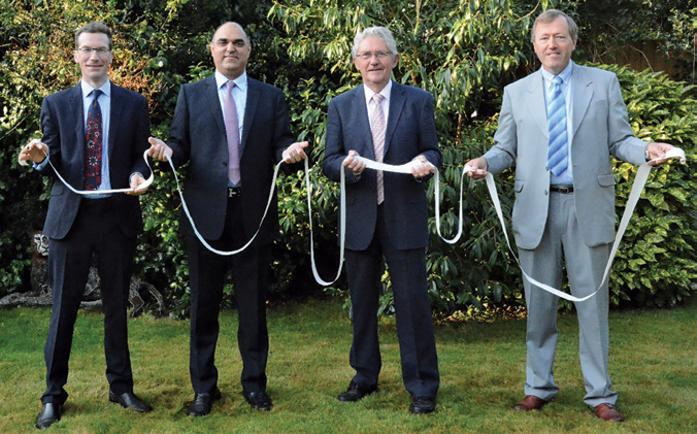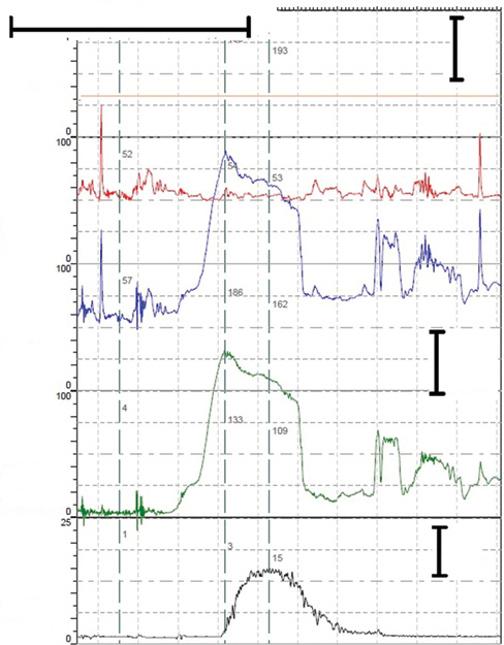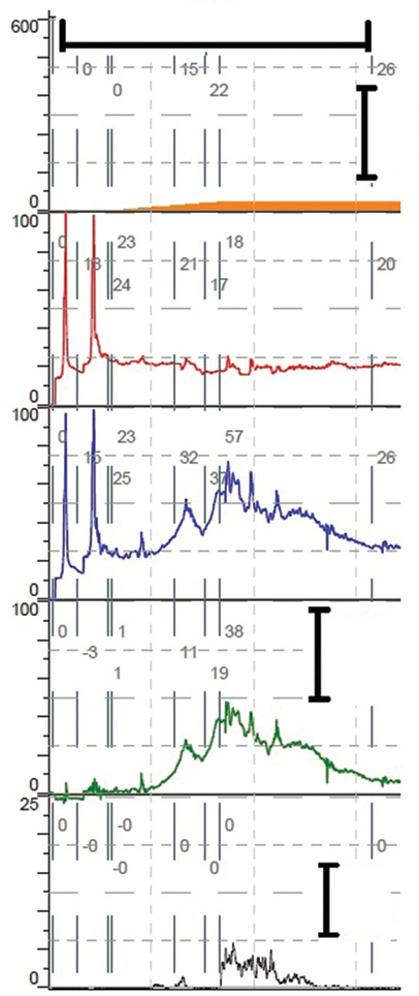Abrams’ Urodynamics
Fourth Edition
Edited by Marcus Drake, MA BM BCh DM FRCS(Urol)
Professor of Physiological Urology and Honorary Consultant Urologist
Translational Health Sciences, Bristol Medical School
Southmead Hospital Bristol, UK
Hashim Hashim, MB BS MD FEBU FRCS(Urol)
Consultant Urological Surgeon & Honorary Professor of Urology
Bristol Urological Institute, Southmead Hospital Bristol, UK
Andrew Gammie, MA CEng MIET CSci MIPEM
Clinical Engineer
Bristol Urological Institute Southmead Hospital
Bristol, UK
This edition first published 2021 © 2021 John Wiley & Sons Ltd
Edition History
Urodynamics, Springer-Verlag London (3e, 2006)
All rights reserved. No part of this publication may be reproduced, stored in a retrieval system, or transmitted, in any form or by any means, electronic, mechanical, photocopying, recording or otherwise, except as permitted by law. Advice on how to obtain permission to reuse material from this title is available at http://www.wiley.com/go/permissions.
The right of Marcus Drake, Hashim Hashim, Andrew Gammie to be identified as the authors of the editorial material in this work has been asserted in accordance with law.
Registered Offices
John Wiley & Sons, Inc., 111 River Street, Hoboken, NJ 07030, USA
John Wiley & Sons Ltd, The Atrium, Southern Gate, Chichester, West Sussex, PO19 8SQ, UK
Editorial Office
9600 Garsington Road, Oxford, OX4 2DQ, UK
For details of our global editorial offices, customer services, and more information about Wiley products, visit us at www.wiley.com. Wiley also publishes its books in a variety of electronic formats and by print-on-demand. Some content that appears in standard print versions of this book may not be available in other formats.
Limit of Liability/Disclaimer of Warranty
The contents of this work are intended to further general scientific research, understanding, and discussion only and are not intended and should not be relied upon as recommending or promoting scientific method, diagnosis, or treatment by physicians for any particular patient. In view of ongoing research, equipment modifications, changes in governmental regulations, and the constant flow of information relating to the use of medicines, equipment, and devices, the reader is urged to review and evaluate the information provided in the package insert or instructions for each medicine, equipment, or device for, among other things, any changes in the instructions or indication of usage and for added warnings and precautions. While the publisher and authors have used their best efforts in preparing this work, they make no representations or warranties with respect to the accuracy or completeness of the contents of this work and specifically disclaim all warranties, including without limitation any implied warranties of merchantability or fitness for a particular purpose. No warranty may be created or extended by sales representatives, written sales materials, or promotional statements for this work. The fact that an organisation, website, or product is referred to in this work as a citation and/or potential source of further information does not mean that the publisher and authors endorse the information or services the organisation, website, or product may provide or recommendations it may make. This work is sold with the understanding that the publisher is not engaged in rendering professional services. The advice and strategies contained herein may not be suitable for your situation. You should consult with a specialist where appropriate. Further, readers should be aware that websites listed in this work may have changed or disappeared between when this work was written and when it is read. Neither the publisher nor authors shall be liable for any loss of profit or any other commercial damages, including but not limited to special, incidental, consequential, or other damages.
Library of Congress Cataloging-in-Publication
Data
Names: Drake, Marcus, editor. | Hashim, Hashim, editor. | Gammie, Andrew, editor. | Abrams, Paul, Urodynamics.
Title: Abrams’ urodynamics / edited by Marcus Drake, Hashim Hashim, Andrew Gammie.
Other titles: Urodynamics
Description: Fourth edition. | Hoboken, NJ : Wiley-Blackwell, 2021. | Preceded by Urodynamics / Paul Abrams. 3rd ed. c2006. | Includes bibliographical references and index.
Identifiers: LCCN 2020040344 (print) | LCCN 2020040345 (ebook) | ISBN 9781118844717 (paperback) | ISBN 9781118844724 (Adobe pdf) | ISBN 9781118844731 (epub)
Subjects: MESH: Urodynamics | Urologic Diseases–diagnosis
Classification: LCC RC874 (print) | LCC RC874 (ebook) | NLM WJ 102 | DDC 616.6/075–dc23
LC record available at https://lccn.loc.gov/2020040344
LC ebook record available at https://lccn.loc.gov/2020040345
Cover Design: Wiley
Cover Images: © Marcus Drake
Set in 9.5/12.5pt STIXTwoText by SPi Global, Pondicherry, India
Contents
Abbreviations ix
Contributors xi
Preface xv
First Foreword xvii
Second Foreword xix
Part I Basic Principles 1
1. Basic Urodynamics and Fundamental Issues 3
Marcus Drake, Andrew Gammie, Laura Thomas, Arturo García-Mora, and Hashim Hashim
2. Applied Anatomy and Physiology 24
Chendrimada Madhu and Marcus Drake
3. The Physics of Urodynamic Measurements 45
Andrew Gammie
Part II Functional Urology 53
4. Patient Assessment 55
Musaab Yassin, Alan Uren, and Nikki Cotterill
5. Treatments for Lower Urinary Tract Dysfunction 73
Sharon Yeo and Hashim Hashim
Part III Urodynamic Techniques 93
6. Uroflowmetry 95
Amit Mevcha and Richard Napier-Hemy
7. Cystometry and Pressure-Flow Studies 109
Marcus Drake, Rachel Tindle, and Su-Min Lee
8. Video Urodynamics 158
Marcus Drake, Michelle Ong, Devang Desai, Michel Wyndaele, Mark Woodward, and Hashim Hashim
9. Ambulatory Urodynamics 193
Julie Ellis-Jones and Wendy Bevan
10. Studies Assessing Urethral Pressures 199
Dharmesh Kapoor and Marcus Drake
11. Non-invasive Urodynamics 217
Alison Bray, Christopher Blake, and Christopher Harding
Part IV Urodynamics in Clinical Practice 227
12. Urodynamics in Children 229
Jonathan S. Ellison, Guy Nicholls, and Mark Woodward
13. Urodynamics in Women 242
Wael Agur, Ruben Trochez, Antonin Prouza, George Kasyan, and Abdelmageed Abdelrahman
14. Urodynamics in Men 273
Arturo García-Mora, Connie Chew, and Marcus Drake
15. Structural Changes of the Bladder Outlet 301
Michelle Ong, Marcus Drake, and Devang Desai
16. Neurological Disease and LUTS 313
Marcus Drake, Jeremy Nettleton, and Mohammed Belal
17. Urodynamics in Older People 360
Su-Min Lee and Emily Henderson
Part V Running a Urodynamics Unit 369
18. Troubleshooting During Urodynamics 371
Laura Thomas, Rachel Tindle, and Andrew Gammie
19. Artefacts in Urodynamics 383
Andrew Gammie
20. Anorectal Physiology 394
Laura Thomas and Kathryn McCarthy
21. Organisation of the Urodynamic Unit 406
Laura Thomas, Alexandra Bacon, Joanne Sheen, and Andrew Gammie
22. Equipment 412
Andrew Gammie
23. Working with Limited Resources 415
Andrew Gammie, Laura Thomas, Marcus Drake, and Eskinder Solomon
24. Research Evidence on the Clinical Role of Urodynamics 420
Andrew Gammie, Marcus Drake, and Hashim Hashim
Appendices
Key Patient Assessment Tools from the International Consultation on Incontinence Questionnaires (ICIQ) 423
ICIQ-FLUTS 423
ICIQ-MLUTS 427
ICIQ-BD 432
Fundamentals Documents from the International Continence Society 434
N&U 2018 Volume 37 Supplement 6 434
Editorial Comment 439
A Commentary on Expectations of Healthcare Professionals When Applying the International Continence Society Standards to Basic Assessment of Lower Urinary Tract Function 440
Fundamentals of Terminology in Lower Urinary Tract Function 446
Basic Concepts in Nocturia, Based on International Continence Society Standards in Nocturnal Lower Urinary Tract Function 453
Neurological Lower Urinary Tract Dysfunction Essential Terminology 458
The Fundamentals of Chronic Pelvic Pain Assessment, Based on International Continence Society Recommendations 465 How to Use the Pelvic Organ Prolapse Quantification (POP-Q) system? 472
The Fundamentals of Uroflowmetry Practice, Based on International Continence Society Good Urodynamic Practices Recommendations 477
Fundamentals of Urodynamic Practice, Based on International Continence Society Good Urodynamic Practices Recommendations 483
Basics of Videourodynamics for Adult Patients With Lower Urinary Tract Dysfunction 494
Why ICS Standardization of Lower Urinary Tract Symptoms Matters 500
Critical Steps in Developing Professional Standards for the International Continence Society 502
Patient Information Leaflets from the Bristol Urological Institute 508
Free Flow Rate Testing 508
Urodynamics 515
Practice, Standards, and Equipment Recommendations 530
International Consultation on Incontinence 2016; Executive Summary: Urodynamic Testing 531
United Kingdom Continence Society: Minimum Standards for Urodynamic Studies, 2018 539
UK Centre for Evidence-Based Purchasing; Buyers’ Guide Urodynamics Systems 571
International Continence Society Good Urodynamic Practices and Terms 2016: Urodynamics, uroflowmertry, cystometry, and pressure-flow study 578
Good Urodynamic Practices Documents from the International Continence Society 595
Good Urodynamic Practices: Uroflowmetry, Filling Cystometry, and Pressure-Flow Studies 596
Index 610
Abbreviations
ACh Acetyl-choline
AD Autonomic dysreflexia
ADH Anti-diuretic hormone
AFC Air-filled catheter
ANP Atrial natriuretic peptide
AP Antero-posterior
ARM Anorectal manometry
ATP Adenosine Triphosphate
AUDS Ambulatory urodynamics
AUS Artificial urinary sphincter
BCI Bladder contractility index
BMI Body mass index
BOO Bladder outlet obstruction
BOOI Bladder outlet obstruction index
BPE Benign prostate enlargement
BPH Benign prostatic hyperplasia
BPS Bladder pain syndrome
BNI Bladder neck incision
BNO Bladder neck obstruction
BNP Brain natriuretic peptide
BPO Benign prostatic obstruction
BTX Onabotulinum toxin-A
BWT Bladder wall thickness
BVE Bladder voiding efficiency
CC Cystometric capacity
CEPNL Cauda equina and peripheral nerves lesion (infrasacral)
CFS Clinical Frailty Scale
CKD Chronic kidney disease
CLPP Cough leak point pressure
CNS Central nervous system
CPAP Continuous positive airway pressure
CSF Cerebrospinal fluid
CSU Catheter specimen of urine
CT Computed tomography
CVA Cerebro-vascular accident
DLPP Detrusor leak point pressure
DLPV Detrusor Leak Point Volume
DO Detrusor overactivity
DOI Detrusor overactivity incontinence
DRE Digital rectal examination
DSD Detrusor sphincter dyssynergia
DUA Detrusor underactivity
ED Erectile dysfunction
EBRT External beam radiotherapy
EMG Electromyogram
EUS External urethral sphincter
FDA Food and Drug administration
FFR Free flow rate
Fr French
FSF First sensation of filling
FUTURE Female Urgency, Trial of Urodynamics as Routine Evaluation
FVC Frequency/volume chart
GI Gastrointestinal
GUP Good Urodynamic Practices
HR-ARM High resolution anorectal manometry
HRM High resolution manometry
IAS Internal anal sphincter
IC Intermittent catheterisation
ICI International Consultation on Incontinence
ICIQ International Consultation on Incontinence Questionnaire
ICIQ-B International Consultation on Incontinence Questionnaire-Bowel symptoms
ICIQ-FLUTS International Consultation on Incontinence Questionnaire-Female LUTS
ICIQ-MLUTS International Consultation on Incontinence Questionnaire-Male LUTS
ICCS International Children’s Continence Society
ICS International Continence Society
IR(ME)R Ionising Radiation (Medical Exposure) Regulations
ISC Intermittent self-catheterisation
ISD Intrinsic sphincter deficiency
IVU Intravenous urogram
x Abbreviations
LUTD Lower Urinary Tract Dysfunction
LUTS Lower Urinary Tract Symptoms
M Muscarinic
MCUG Micturating cystourethrogram
MRI Magnetic resonance imaging
MS Multiple sclerosis
MSA Multiple system atrophy
MSU Mid-stream urine
MUCP Maximum urethral closure pressure
MUI Mixed urinary incontinence
MUP Maximum urethral pressure
MUT Midurethral tape
MVV Maximum voided volume
NIRS Near infrared spectroscopy
NLUTD Neurogenic Lower Urinary Tract Dysfunction
NDV Normal desire to void
NICE National Institute for Health and Clinical Excellence
NP Nocturnal polyuria
NPH Normal pressure hydrocephalus
NPi Nocturnal polyuria index
NUV Nocturnal urine volume
OAB Overactive bladder
OSA Obstructive sleep apnoea
PA Postero-anterior
pabd Abdominal pressure
PAG Periaqueductal grey
PCR Penile compression-release
PD Parkinson’s disease
pdet Detrusor pressure
pdetQmax Detrusor pressure at maximum flow rate
PFC Prefrontal cortex
PFME Pelvic floor muscle exercises
PFS Pressure-flow studies
PMC Pontine micturition centre
PMD Post-micturition dribble
PNS Parasympathetic nervous system
POP Pelvic organ prolapse
POP-Q Pelvic organ prolapse quantification
PPI Post-prostatectomy incontinence
PRIMUS PRImary care Management of lower Urinary tract Symptoms
PRO Patient-reported outcomes
PSA Prostate-specific antigen
PTNS Percutaneous tibial nerve stimulation
pura Urethral pressure
PUV Posterior urethral valves
pves Vesical pressure
PVR Post-void residual
Qmax Maximum flow rate
RAIR Recto Anal Inhibitory Reflex
SBO Spina bifida occulta
SCI Spinal cord injury
SDV Strong desire to void
SPL Suprapontine lesion
SSCL Sacral Spinal Cord lesion
SSL Suprasacral spinal cord/pontine lesion
SNM Sacral neuromodulation
SNS Sympathetic nervous system
SUI Stress urinary incontinence
TURP Transurethral resection of the prostate
TVT Transvaginal tape
TWOC Trial without catheter
UAB Underactive bladder
UDS Urodynamics
UPP Urethral pressure profile
UPSTREAM Urodynamics for Prostate Surgery: Randomised Evaluation of Assessment Methods
USI Urodynamic stress incontinence
UTI Urinary tract infection
UUI Urgency urinary incontinence
UUT Upper urinary tract
VLPP Valsalva leak point pressure
VUDS Video-urodynamics
VUJ Vesicoureteric junction
VUR Vesicoureteric reflux
VV Voided volume
VVF Vesico-vaginal fistula
WFC Water-filled catheter
Contributors
Abdelmageed Abdelrahman, MBBCh, BAO, DIPM, DFSRH, MRCOG, MSc
Subspecialty Trainee in Urogynaecology, Liverpool Women’s Hospital NHS Foundation Trust, Crown Street, Liverpool, UK
Wael Agur, MB, BCh, MSc, MD(res), FRCOG
Subspecialist Consultant Urogynaecologist, NHS Ayrshire & Arran University Hospital Crosshouse, Kilmarnock, UK
Alexandra Bacon, MSc
Clinical Scientist, Urodynamics & Gastrointestinal Physiology, Southmead Hospital, Bristol, UK
Mohammed Belal, MA, MB, BChir, FRCS(Urol)
Consultant Urological Surgeon, Department of Urology, University Hospitals Birmingham, Mindelsohn Way, Edgbaston, Birmingham, UK
Wendy Bevan
Registered Nurse, Senior Urodynamic Nurse (Ret’d), Urodynamics Department, Bristol Urological Institute, North Bristol NHS Trust, Southmead Hospital, Bristol, UK
Christopher Blake, FRCS(Urol) MD
Consultant Urological Surgeon, Royal Cornwall Hospital, Treliske, Truro, Cornwall, UK
Alison Bray, BSc, PhD
Northern Medical Physics and Clinical Engineering Department, The Newcastle upon Tyne Hospitals NHS Foundation Trust, Royal Victoria Infirmary, Newcastle upon Tyne, UK
Connie Chew, RGN
Senior Urodynamic Nurse, Urodynamics Department, Bristol Urological Institute, North Bristol NHS Trust, Southmead Hospital, Bristol, UK
Nikki Cotterill, PhD, BSc(Hons), RN
Associate Professor in Continence Care, University of the West of England, Bristol Urological Institute, Learning and Research, Southmead Hospital, Bristol, UK
Devang Desai, MB BS, MS, FRACS(Urology)
Associate Professor of Urology, University of Queensland, Toowoomba Base Hospital, Queensland, Australia
Julie Ellis-Jones, DPhil, MSc, RN, RNT
Senior Lecturer in Adult Nursing, University of the West of England, Bristol, UK
Jonathan S. Ellison, MD
Assistant Professor, Urology Dept., Children’s Hospital of Wisconsin & Medical College of Wisconsin, Children’s Corporate Center Suite 330, Milwaukee, WI, USA
Arturo García-Mora, MD
Head of Functional Urology and Urodynamics, Instituto Nacional de Ciencias Médicas y Nutrición “Salvador Zubirán”, Hospital Médica Sur Mexico City, México
C. K. Harding, MA, MB, BChir, MD, FRCS(Urol)
Consultant Urological Surgeon, Freeman Hospital, Newcastle upon Tyne Hospitals NHS Foundation Trust, Freeman Rd, High Heaton, Newcastle upon Tyne, UK
Emily Henderson, MB, ChB, MRCP, PhD
Consultant Senior Lecturer, Honorary Consultant Geriatrician, Population Health Sciences, Bristol Medical School, University of Bristol, Senate House, Tyndall Ave, Bristol, UK
Dharmesh Kapoor, MB, BS, MD, FRCOG Consultant Gynaecologist and Subspecialist in Urogynaecology, Mumbai, India
George Kasyan, MD, PhD Professor of Urology, Urology Department, Moscow State University of Medicine and Dentistry, Moscow, Russian Federation
Su-Min Lee PhD, MBChB, MRCS Urology Registrar, Department of Urology, Royal United Hospital, Combe Park, Bath, Somerset, United Kingdom, UK
Chendrimada Madhu, MD, MA, MRCOG, FHEA
Consultant Gynaecologist, Subspecialist in Urogynaecology, Department of Women’s Health, The Chilterns, Southmead Hospital, Bristol, UK
Kathryn McCarthy MB, BS, MD, MRCS, FRCS(Gen Surg) Consultant in Colorectal Surgery, Department of General Surgery, Southmead Hospital, Bristol, UK
Amit Mevcha, MBBS, MRCS, FRCS (Urol) Consultant Urologist, Royal Bournemouth Hospital, Bournemouth, UK
Richard Napier-Hemy, MB, ChB, FRCS(Urol) Consultant Urological Surgeon, Manchester Royal Infirmary, Manchester, UK
Jeremy Nettleton, MBBS, Bsc (Hons), FRCS(Urol)
Consultant Urological Surgeon, Cheltenham General Hospital, Gloucestershire Hospitals NHS Foundation Trust, Sandford Rd, Cheltenham, UK
Guy Nicholls, BSc, MD, FRCS (Paeds)
Consultant Paediatric Surgeon and Urologist, Bristol Royal Hospital for Children, Upper Maudlin Street, Bristol, UK
Michelle Ong, MBBS (Hons) Resident in Urology, Toowoomba Base Hospital, South Toowoomba, Queensland, Australia
Antonín Prouza, MD
Senior Clinical Fellow in Female and Functional Urology, Bristol Urological Institute, Southmead Hospital, Bristol, UK
Joanne Sheen
Senior Administrator, Bristol Urological Institute, Southmead Hospital, Bristol, UK
Eskinder Solomon, MSc, MEng Consultant Clinical Scientist, Department of Urology, Guy’s and St Thomas’ Hospital and Department of Paediatric Nephro-Urology, Evelina Children’s Hospital, London, UK
Laura Thomas, MSc Clinical Scientist, Urodynamics & Gastrointestinal Physiology, Southmead Hospital, Bristol, UK
Rachel Tindle, MSc Clinical Scientist, Urodynamics & Gastrointestinal Physiology, Southmead Hospital, Bristol, UK
Ruben Trochez, MBBS, MRCOG Consultant Urogynaecologist, Liverpool Women’s Hospital NHS Foundation Trust, Crown Street, Liverpool, UK
Alan Uren, BSc(Hons), MPH Specialist Clinical Researcher, Bristol Urological Institute, Southmead Hospital, Bristol, UK
Mark Woodward, MD, FRCS (Paed Surg)
Consultant Paediatric Urologist, Bristol Royal Hospital for Children, Upper Maudlin Street, Bristol, UK
Michel Wyndaele, MD, PhD, FEBU
Urology Consultant, Division of Surgical Specialties, Department of Urology, University Medical Center Utrecht, Heidelberglaan 100, The Netherlands
Musaab Yassin Consultant Urologist, Oxford University Hospitals NHS Foundation Trust, Churchill Hospital, Oxford, UK
Sharon Yeo, MBBS, MRCS (Glasg), MMed (Surgery), FAMS (Urology)
Senior Consultant and Head Department of Urology, Tan Tock Seng Hospital 11 Jalan Tan Tock Seng, Singapore
Preface
Lower urinary tract dysfunction (LUTD) produces a large burden on sufferers in particular, and on society in general. Lower urinary tract symptoms (LUTS) are very prevalent; 5% of children aged 10 years wet the bed. In all, 15% of women and 7% of men have troublesome incontinence. In elderly men of 75 years, benign prostatic hyperplasia occurs in more than 80% of individuals, with benign prostatic enlargement coexisting in up to half this group and half of these having bladder outlet obstruction. Most people with a neurological disease have some form of LUTD.
Urodynamics is invaluable in assessing people with LUTD. The need to support the clinical assessment with objective measurement is accepted by most clinicians specialising in the care of patients with LUTS. Since the first edition of this book in 1983, urodynamics has become more widely accepted. The number of urodynamic units worldwide has increased to enable access to this important testing modality. Almost every hospital of any significance embraces urodynamic investigations as an essential part of the diagnostic pathway for urology and gynaecology departments. Further, specialists in geriatrics, paediatrics and neurology recognise the importance of urodynamics in the investigation of a significant minority of their patients. The expertise involved in assessing neurogenic LUTD by urodynamicists can help neurologists refine their insights into the neurological deficit in individual patients. However, the take-up is not universal, especially worldwide. This may result from the perceived cost to the healthcare unit, the presumed unpleasantness to the patient, and the varied expertise in functional urology.
The objective of this book is to deliver a definitive manual of practical urodynamics, showing how urodynamic investigation contributes to the management of patients and describing the tests clearly and comprehensively. To do this means not only discussing the tests but also showing in which clinical areas they help management and those
where urodynamic tests are largely pointless. It means concentrating on the common clinical problems and on the presenting symptom complexes, while pointing out any limitations and possible artefacts of investigation.
The Bristol Urological Institute (BUI) serves a large patient population in South West England and has developed skills in urodynamics and functional urology over several decades. It runs educational courses (the Basic Urodynamics course, the Certificate of Urodynamics, and the Expert Urodynamics course) which take place in the UK and several places globally, and also online. This makes the BUI one of the world-renowned leading units in female and functional urology generally, and urodynamics specifically, that is visited by healthcare professionals from all over the world. Professor Paul Abrams was not the only individual responsible for this strength, but his contributions to Urology in Bristol and worldwide are truly impressive. They include the development of the Abrams-Griffiths nomogram [1], which was adopted by the International Continence Society (ICS) as the Bladder Outlet Obstruction Index. He was a major promoter of the ICS Standardisations of Terminology in Lower urinary tract function, including being the first author on the paper which has been more widely quoted from urology than any other [2]. He also serves as one of the Chairs of the International Consultations on Incontinence. When he wrote the preceding editions of this book, his aim was to help a clinician with no previous experience in urodynamics to appreciate both the value and limitations of the subject and give the necessary practical advice on the use of the appropriate equipment in the correct situations. This was delivered with characteristic wit and imagination (see figure). One of the principal reasons for producing the 3rd edition was the publication of the ICS terminology report and the ‘Good Urodynamic Practices’ document [3]. With the updating of Good Urodynamic Practices [4], and
now the ‘Fundamentals of Urodynamic Practice’ document [5], it is timely to continue Professor Abrams’ achievements in this fourth edition, the first to become an eponymous Abrams’ Urodynamics. In it, we have aimed to stay true to the importance of the practical application of urodynamic tests, we draw on the latest scientific evidence, have sourced an extensive new tranche of illustrations, and have revisited the ICS Standardisations to reflect their revisions in recent years. In doing so, we wish to record our personal appreciation of and debt to Paul Abrams’ inspiration, leadership, and support of us and countless others in this field.
Marcus Drake, Hashim Hashim, Andrew Gammie, 2020 Bristol Urological Institute and University of Bristol
References
1 Abrams, P.H. and Griffiths, D.J. (1979). The assessment of prostatic obstruction from urodynamic measurements and from residual urine. Br. J. Urol. 51 (2): 129–134.
2 Abrams, P., Cardozo, L., Fall, M. et al. (2002). The standardisation of terminology of lower urinary tract function: report from the Standardisation Sub-committee of the International Continence Society. Neurourol. Urodyn. 21 (2): 167–178.
3 Schafer, W., Abrams, P., Liao, L. et al. (2002). Good urodynamic practices: uroflowmetry, filling cystometry, and pressure-flow studies. Neurourol. Urodyn. 21 (3): 261–274.
Figure A classic picture of the fundamental insights on the implications of prostate pathology for the male lower urinary tract, showing the relationships between benign prostate hyperplasia (BPH), benign prostate enlargement (BPE), and benign prostate obstruction (BPO). Source : Drawn by Alex James from a sketch by Paul Abrams in 1993.
4 Rosier, P., Schaefer, W., Lose, G. et al. (2017). International Continence Society Good Urodynamic Practices and Terms 2016: Urodynamics, uroflowmetry, cystometry, and pressure-flow study. Neurourol. Urodyn. 36 (5): 1243–1260.
5 Drake, M.J., Doumouchtsis, S.K., Hashim, H., and Gammie, A. (2018). Fundamentals of Urodynamic Practice, based on International Continence Society Good Urodynamic Practices recommendations. Neurourol. Urodyn. 37 (S6): S50–S60.
First Foreword
I feel honoured and humbled to find my name attached to this new edition, but need to set the record straight! After graduating from Sheffield, I arrived in Bristol in 1972 to begin my surgical training. The surgical registrar (resident) was Michael Torrens, who was a neurosurgical resident, and about to become Roger Feneley’s new research fellow in the newly founded urodynamic unit. Mike was going to use urodynamics to evaluate sacral neurectomy in women with intractable detrusor overactivity, then called ‘detrusor instability’. After six months of general surgery, I rotated to the urology department and got interested in the older men coming for TURP for their ‘prostatism’. Even then I was an annoying and inquisitive individual who constantly asked, ‘Why ……. ?’. Mike suggested that I approach Roger to see whether I could start to assess these men, initially by urine flow measurement. I describe these beginnings of my urological life, as they were determined by serendipity. The opportunities I was given, and those I worked with, in that first year in Bristol determined the rest of my professional career. Mike’s early encouragement and advice, and Roger’s mentorship throughout, have been the bedrock of my professional development. Roger provided the environment where all young, naive but enthusiastic clinicians could speak without fear, knowing that their unanswered questions could be pursued in an academically sound manner according to the null hypothesis. It has been my privilege and pleasure to work in academic and clinical teams that have been devoted to patient care, and free of rancour and division. The stability of the urodynamic team in Bristol was anchored by Roger initially, then by Angela Shepherd, followed by Lucy Swithinbank and now by Hashim Hashim. The technical side of urodynamics is also of paramount importance to the quality of service. From the beginning, Pat Lewis and then Sue Howell ensured that Bristol Urodynamics adhered to high technical standards, and the clinicians were kept on the ‘straight and narrow’: any upstart doctor was reminded who were the most important members of
staff! We have continued to be most fortunate in having excellent scientific colleagues. Andrew Gammie is our first clinical engineer, and Laura Thomas is our first clinical scientist. With their involvement, not only has our urodynamic quality advanced, but our teaching activity too has been able to improve in quality.
I owe great debts to many others. I met and worked with Derek Griffiths, then in the physics department at Exeter. He was my urodynamic and scientific mentor, and he taught me ‘intellectual honesty’ – what I knew from what I thought I knew. We collaborated for many years, even after he moved to Holland and then to North America. Early on, I met Alan Wein and Linda Cardozo, who have both been very important in developing functional urology worldwide, and together we have worked closely with the International Continence Society (ICS) and in developing the International Consultation on Incontinence (ICI), and from that the ICI Research Society. Saad Khoury has been another valued mentor who made the ICI possible and has been an important and wise counsel for many years. The camaraderie of these old friends has been very important to me.
Urodynamics remains a controversial subject to the ‘non-believers’, and there remains much to be achieved in identifying its exact place in the evaluation of lower urinary tract dysfunction (LUTD). What is clear is that the a priori argument remains: the bladder, urethra and sphincter are, in engineering terms, a reservoir, outlet and valve, and therefore must be studied by pressure and flow measurements. The United Kingdom Continence Society (UKCS) has led the way in determining how urodynamics can improve and reach the quality standards of other physiological measurement units. Another of the fundamental problems, in managing patients’ problems, is that the LUT is connected to the brain. Of course, this is essential, but it leads to enormous problems, as the nervous system is so incompletely understood. In any urodynamic team, there has to be a basic science including neurophysiological input, and Marcus Drake has
added that dimension to our work. Advances will not come until we develop our understanding of the interactions between the nervous system and the LUT. Marcus, like many other members of the urodynamic team, has completed his training in other centres, and this crossfertilisation by ideas is essential for creative thinking. I am proud that I have had a part in appointing colleagues who will develop a wider range of skills than I have had. This is never a threat, only an opportunity.
We all have the duty to educate, and I hope this book will support that effort. Finally, I must thank my wife Kirsten and my children, the members of ‘my crew’, who ground me when necessary, and are ever tolerant and
supportive. They have certainly become familiar with the basics of lower urinary tract function! So, in addition to developing the science of urodynamics, we have to help all people, as well as patients, to better understand their bladder function so that they can preserve their bladder health and help themselves when it ‘plays up’.
Thank you, Marcus, Andrew and Hashim, for your collaboration in science and clinical work and for your friendship.
Professor Paul Abrams, Bristol December 2020
Figure Marcus Drake, Hashim Hashim, Paul Abrams, and Andrew Gammie holding an extremely long flowmetry printout that exemplifies slow flow and terminal dribble. Bristol, September 2020.
Second Foreword
The name ‘Paul Abrams’ has been synonymous with expertise in many subjects associated with normal function and lower urinary tract dysfunction (LUTD), but none more so than the science, performance, interpretation and clinical utility of urodynamics of the LUT. I thought that I was a good organiser of subject material and a good and succinct writer when I picked up the first edition of Urodynamics in 1983, but I had to tip my hat to Paul. The 229 pages of this text rapidly became the ‘gold standard’, and the charts, tables and diagrams quickly became a part of my own presentations on the subject (properly referenced, of course!). I found the organisation of the subject, which included the science necessary to understand what happens during filling/storage and emptying/voiding, and how to properly measure and categorise the findings, to ‘make sense’ and enable understanding of where these straightforwardly explained techniques fit into the overall evaluation of LUTD. The notes on management were a bonus.
Subsequent editions (I am looking at the third now - 331 pages) have expanded the concepts and techniques that have occurred parallel to the advances in the related scientific disciplines, just as the terminology has evolved (please do not ever say ‘urge incontinence’ as opposed to ‘urgency incontinence’ in Paul’s presence!). It is only fitting that the title of this book, the most complete text on the science and practice of urodynamics, now be preceded by Paul’s name and carried on by members of the department that he developed.
Paul, congratulations on having the text renamed Abrams’ Urodynamics, an honour well deserved!
Alan J. Wein, MD, PhD(hon), FACS Professor with Tenure and Emeritus Chief of Urology Perelman School of Medicine at the University of Pennsylvania Penn Medicine Philadelphia, Pennsylvania, USA
1 Basic Urodynamics and Fundamental Issues
Marcus Drake1, Andrew Gammie2, Laura Thomas3, Arturo García-Mora4, and Hashim Hashim2
1 Translational Health Sciences, Bristol Medical School, Southmead Hospital, Bristol, UK
2 Bristol Urological Institute, Southmead Hospital, Bristol, UK
3 Urodynamics & Gastrointestinal Physiology, Southmead Hospital, Bristol, UK
4 Instituto Nacional de Ciencias Médicas y Nutrición “Salvador Zubirán”, Hospital Médica Sur, Mexico City, México
CONTENTS
Introduction to Urodynamics, 3
The Urodynamic History and Examination, 5
The Aims and Considerations of Urodynamics, 6 Basics of Urodynamics, 9
What Is Urodynamics?, 9
What Is Measured?, 10
Setting Up the Equipment, 11
Running the Test, 12
Troubleshooting, 13
Introduction to Urodynamics
Urodynamics has two basic aims:
● To reproduce the patient’s symptomatic complaints while making key observations
● To provide a pathophysiological explanation by correlating the patient’s symptoms with the urodynamic findings
These two basic aims are crucial to the purpose of urodynamics – essentially, it is a diagnostic test that will aid in the management of patients. The need to make urodynamic observations reflects the fact that the patient’s symptoms are important, but they might be somewhat misleading. Most patients with lower urinary tract dysfunction (LUTD) present to their doctor with symptoms. However, lower urinary tract symptoms (LUTS – Table 1.1) should not simply be taken at face value, since a range of differing mechanisms may result in rather similar symptomatic presentations. The statement ‘the bladder is an unreliable witness’ [2] reflects how symptoms are the starting point but do not actually identify the ultimate explanation. Since treatment should
Fundamentals, 14 ‘Occult’ Neurological Disease, 14
How a Urodynamic Trace Should Be Presented, 16 Adhering to High Standards, 17
Safety of the Urodynamics Staff, 19
A Brief History of Urodynamics, 19 Summary, 21 References, 22
correct the underlying cause, it is necessary to identify mechanisms, avoiding assumption or prejudice coming from taking symptoms at face value. An excellent example of this is voiding LUTS in men, where the cause on urodynamic testing may prove to be bladder outlet obstruction (BOO) and/or detrusor underactivity (DUA); BOO should respond fully to surgery to relieve obstruction such as transurethral resection of prostate (TURP), while such surgery is potentially not helpful in the second [3]. Voiding LUTS in males are of unreliable diagnostic value, and only slow stream and hesitancy show any correlation with the urodynamic findings of BOO [4–6]. Even with flow rate assessment, one cannot be sure whether BOO is present (Figure 1.1). The difficulty of assessing LUTD by symptoms alone is the uncertainty about establishing truly what is going on in the individual describing them.
For women diagnosed by their symptoms as having stress urinary incontinence (SUI), only 50–68% have urodynamic stress incontinence (USI) [7, 8]. These studies also looked at patients with apparent overactive bladder (OAB) symptoms presumed to be the result of detrusor overactivity (DO), and here, the correspondence was
Abrams’ Urodynamics, Fourth Edition. Edited by Marcus Drake, Hashim Hashim, and Andrew Gammie.
Table 1.1 Classification of lower urinary tract symptoms (LUTS) [1].
Storage
Urgency
Urinary incontinence
Increased daytime frequency
Nocturia
Pain
Voiding
Slow stream
Splitting/spraying
Intermittency
Hesitancy
Straining
Terminal dribbling
Post-micturition
Post-micturition dribbling
Feeling of incomplete emptying
Note: Do NOT forget to enquire about Pelvic Organ Prolapse in Women and Erectile Dysfunction in Men.Source: Modified from Abrams et al. [1].
Figure 1.1 Flow rate testing in men gives an uncertain understanding. This man had previously done a free flow rate test which showed a reasonable maximum flow rate of 16 ml/s; taken alone, this might suggest he does not have bladder outlet obstruction (BOO). However, when he attended for urodynamics (see the pressure-flow study illustrated above), his flow rate was 15 ml/s as shown, but the pressure needed to achieve this was high, indicating BOO is present (see Chapter 14 for more details on assessing BOO in men).
33–51%. A key factor is the link to coughing, often used as a question to elicit a history of SUI; if a woman says ‘I leak when I cough’, it sounds like SUI. However, a cough can be a trigger to set off an overactive detrusor contraction, leading to detrusor overactivity incontinence (DOI) (Figure 1.2).
Thus, the history may suggest that SUI treatment is needed, but for some of these women, the urodynamic observation identifies that DO treatment is the appropriate choice.
Accordingly, in both men and women, there is potential mismatch between reported LUTS and the LUTD identified by detailed investigation. This issue is particularly prominent in people with neurological conditions and children. In neurological disease, it is common for sensation to be absent or abnormal, making LUTS even more difficult to interpret. Children may find it difficult to describe their symptoms in any setting and particularly in a healthcare environment. Because symptoms have been shown to lack diagnostic specificity in the key clinical groups, it is not surprising to find that when surgery was based on symptoms alone, the results could be unsatisfactory. Urodynamic studies provide explanations for many symptoms based on mechanism and accordingly provide better support for therapy selection.
There is a well-recognised and substantial placebo effect for therapy in patients with LUTS. The symptoms of men with proven BOO, secondary to benign prostatic enlargement (BPE), can be improved in 40–60% of men in the placebo arm of drug studies. Such an effect can be surmised in men undergoing prostate surgery, but usually it is not sustained and in due course will be counterbalanced by the other effects of surgery, notably impairment of sexual function. Some patients submitted for surgery without objective confirmation of their condition potentially can do badly; this might reflect a poor-quality operation, or it may be that the problem lay in the preceding assessment. Urodynamics in modern practice gives greater insight into each patient’s LUTD and hence helps advise patients on potential benefit and risks for intervention, to support their expectations of informed decision-making.
Ultimately, a successful urodynamics test is a clinically relevant investigation which seeks:
● to reproduce the patient’s symptoms,
● to define bladder and urethral function,
● to provide precise diagnoses,
VH2O (ml)
Pabd (cmH2O)
Pves (cmH2O)
Pdet (cmH2O)
Flow (ml/s)
Figure 1.2 A woman who reported leakage with coughing in her history, suggestive of stress urinary incontinence (SUI). Her urodynamic test showed cough-provoked detrusor overactivity (DO) incontinence, and she described this as representative of her presenting complaint. Hence, this is not urodynamic stress incontinence, but effort-provoked detrusor overactivity incontinence; the symptomatic presentation was misleading and could have led to inappropriate surgery for SUI (see Chapter 13 for more details on assessing incontinence in women).
● to define the most significant abnormality,
● to allow selection of most appropriate treatment, and
● to predict post-operative problems.
This book describes how these can be achieved across a wide range of settings, complying with modern practice
standards, and how to deal with challenges that may be encountered.
The Urodynamic History and Examination
When meeting a new patient with LUTS, it is important to establish a rapport. The LUTS present must be captured systematically, identifying the severity of individual symptoms and the bother each causes to the patient, preferably by using a symptom score completed before the appointment. There are several developed by the International Consultation on Incontinence Questionnaires group [9] which can suit a wide range of patients. They have the advantage of efficiently capturing both severity and bother for each symptom.
The history needs to cover several influences, for example:
● previous urological treatments,
● urinary tract infections (UTIs) – confirmed or suspected,
● obstetric and gynaecological background (in women),
● bowel function,
● sexual problems, including sexual trauma in the past, or recent emergence of sexual dysfunction,
● medical problems and medications, and
● the possibility of an underlying neurological condition.
Malignancy and neurological disease are key considerations. Undiagnosed cancer, such as bladder, prostate, gynaecological, or pelvic malignancy, must also be considered and is potentially at the back of the patient’s mind, even if they don’t say so [10]. Most patients with neurological disease have been diagnosed as such before coming to have LUTS assessed. However, some conditions can cause LUTS early on in the disease process. In these patients, it is possible that no one has yet realised the situation. Urological clinics sometimes encounter LUTS which turn out, on investigation, to have been caused by a neurological problem that has not yet been diagnosed –‘occult neurology’ [11]; the main conditions which can cause this sort of situation are described in the last part of this chapter.
Patients referred for urodynamics will have been examined in a general way, either in the hospital clinic from which the referral originated, or by the patient’s general practitioner (primary care physician). Hence, the urodynamic staff should concentrate efforts on a physical examination relevant to the symptomatic complaints and the possible underlying pathophysiological processes, for example:
● features suggestive of wider problems, such as neurological disease (e.g. slurred speech, altered gait, and tremor), 30
● abdominal examination to identify scars from previous surgery, or a distended palpable bladder, and
● internal examination to assess pelvic floor tone and contraction, pelvic organ prolapse, or formal prostate evaluation.
Urine examination should be performed in all patients, in the form of a urine dipstick to help rule out obvious causes for the LUTS. Other tests, such as blood tests (e.g. renal function and prostate-specific antigen), radiology, and endoscopy, have their indications and may need to be conducted alongside the ongoing LUTD assessment in accordance with the applicable clinical guidelines.
Invasive urodynamic studies are generally not indicated early in the pathway. They follow on once
1) careful investigations have been performed to exclude other pathologies that might mimic LUTD,
2) a bladder diary has been completed,
3) urinary free flow rate test and post-void residual (PVR) have been done, and
4) conservative treatment, which may include testing out response to medications, has been undertaken for a sufficient duration.
The Aims and Considerations of Urodynamics
A urodynamic test has several aims:
● To reproduce the patient’s symptoms
● To define bladder and urethral function
● To provide precise diagnoses
● To define the most significant abnormality
● To allow selection of most appropriate treatment
● To predict potential post-operative problems
● To assess the results of treatment
The prelude to a urodynamic test is to identify the information needed, which can be described as ‘formulating the urodynamic question’. The needs of the patient are fundamentally to resolve bothersome symptoms and reduce possible future problems. The history, symptom score, and bladder diary will help specify the situation. It follows that the needs of the clinician are to help suitable therapy selection and ensure avoidance of harm by identifying causative mechanisms. The urodynamicist should be considering ‘what do I want to know about this patient?’ It can be considered in terms of the micturition cycle (‘What is wrong with storage, what is wrong with voiding?’) and in terms of the lower urinary tract organs (‘What is wrong with the bladder, what is wrong with the bladder outlet?’). In this way, the urodynamicist is in a position to consider ‘Which urodynamic investigations need to be performed to define this patient’s problems?’
This question will concentrate the clinician’s thought processes on undertaking only those investigations which can help to make the diagnosis or indicate the line of management. For example, if a young male patient previously had urethral stricture treatment and voiding LUTS have returned, urine flow measurement will be the principal urodynamic test to identify if stricture recurrence is likely.
Once the questions have been defined, it will become apparent which urodynamic tests to do, as discussed below. The next question should be: ‘Is the investigation likely to be of benefit to the patient?’ This question reflects how the increased knowledge generated by the test might influence the clinical management. Several aspects are relevant, including:
1) Individual considerations: Is there therapy available, and is the patient healthy enough to tolerate the therapy?
2) Disease knowledge: In a difficult clinical area without effective treatment, urodynamic insights may facilitate introduction of treatment options in the future. An example is the introduction by the International Continence Society (ICS) of the concept of underactive bladder syndrome [12], which currently has no specific effective treatment but which will stand a better chance of future therapy development now that a terminology framework is in place.
3) Financial cost and risks of testing: The incidence of UTI after a UDS test is 2–3%, and some discomfort may be experienced.
4) Potential harm the tests could do: In particular, ‘Is the urodynamic unit able to make a reliable diagnosis?’ with erroneous diagnosis being the greatest concern. Three factors are crucial:
● The urodynamic technique should be free of technical artefacts.
● The results of investigations should be reproducible.
● The clinician should be properly trained and able to interpret the results of the urodynamics (Figure 1.3).
From a technical point of view, the tests must be carried out in a careful way, continuously monitoring during the test and eliminating artefacts (see Chapters 18 and 19). The clinician needs to allow for variation in LUTS from day to day and symptomatic progression over longer timescales. At the end of the urodynamic tests, it is pertinent to ask ‘Did the urodynamic studies reproduce the patient’s complaints and did the complaints correlate with known urodynamic features?’ Answers to this question would be yes, no, or partially.
In the Bristol unit, we believe the presence of the clinician, or an experienced practitioner who is aware of the therapeutic possibilities of subsequent treatment, is very beneficial during tests. This individual can then consider

Figure 1.3 The importance of training and interpretation. This trace shows a brief moment from a filling cystometry. It illustrates a transient rise in detrusor pressure after a cough (green tracing), which resembles the detrusor overactivity (DO) seen in Figure 1.2 (but with no associated incontinence). Inspection of the bladder pressure trace (blue tracing) shows there was no bladder contraction associated with the detrusor pressure change, so this is not DO- despite the appearance. The actual explanation is that the cough caused the rectal catheter to shift, causing the recorded drop in abdominal pressure (red tracing) – an entirely different process from an involuntary bladder contraction. Proper training and interpretation will ensure that a mistaken diagnosis of DO is avoided.
whether the sensations felt by the patient during testing fit with the patient’s reported everyday experiences and how they may relate to the urodynamic observations. Occasionally, during urodynamic studies, the patient may complain of a symptom they do not generally experience in everyday life, for example, urgency. Alternatively, a urodynamic abnormality may be noted which does not correlate with the patient’s symptoms. These discrepancies can be detected and put into perspective if the clinician is present. However, if the urodynamics is delegated to someone with minimal urodynamic experience, the matching of LUTS to observations which underpins therapy selection is less direct. They may likely develop a basic test report which is observational and does not have the clinical interpretations at its heart. This report is of huge importance in therapy decision-making, with potentially life-long implications for the patient. Accordingly, a surgeon making decisions based on a basic report must consider: ‘Does the report make sense in the context of the patient’s symptoms and preceding tests?’ and ‘Can the features mentioned in the report be identified on the plotted traces, and is anything visible on the traces not mentioned in the report?’
In some instances, more than one abnormality is detected, so it is important to ask: ‘Can urodynamics decide which abnormality is the most significant, if more than one is detected?’ Multiple abnormalities are commonly seen in patients with neurogenic LUTD. They also occur in non-neurological patients, such as in women with mixed urinary incontinence. Treatment should be directed to the most significant and/or troublesome abnormality. Hence, the correspondence between the patient’s symptomatic complaint and the urodynamic findings is important and needs to be documented in the report.
As well as seeking answers to the above questions, the urodynamicist needs to define the goals of the invasive urodynamic investigation, and these can be listed as follows:
● To increase diagnostic accuracy above that which can be achieved by non-urodynamic means.
● To make a diagnosis on which a management plan can be based. OAB is usually treated empirically; if a patient fails conservative and medical therapy, urodynamic proof of DO is appropriate prior to invasive surgery.
● If there are coexisting abnormalities, to provide evidence to determine which abnormality should be treated first. In a female patient with mixed urinary incontinence, it is usually possible to decide which is the main problem and so establish the treatment priority by careful assessment during urodynamics.
● To define the current situation as a baseline for future surveillance. In spinal cord trauma, it is usual to perform urodynamics after spinal shock has resolved. These baseline urodynamics establish whether there is a detrusor contraction in reaction to bladder filling and
whether or not detrusor-sphincter-dyssynergia (DSD) has developed. DSD is a potentially dangerous condition, as discussed in Chapter 16.
● To predict problems that may follow treatment interventions. Elderly men with BOO and coexisting DO should be warned that whilst their urine flows and other voiding symptoms should be improved by TURP, OAB symptoms due to DO may persist and in fact leakage due to the DO may occur.
● To provide evidence that decides the timing of treatment. In patients with neurological disease (e.g. meningomyelocele) being treated by antimuscarinics, ultrasound may show the development of upper tract dilatation. Urodynamics are vital to confirm whether or
not poor bladder compliance is the cause, such that intervention is needed.
● To exclude abnormalities which might interfere with the management. For example, in patients with SUI being considered for an artificial urinary sphincter (AUS), demonstration of DO or poor bladder compliance would indicate the need for extra treatment to ensure that the additional problem is resolved (Figure 1.4).
● To assess the natural history of LUTD. Our unit, by investigating men and women studied many years ago, provided important evidence as to the natural history of LUT dysfunction [3, 13, 14].
● To assess the results of treatments. Simple urodynamics tests, such as urine flow studies, should be used

Figure 1.4 A man with a functioning artificial urinary sphincter (AUS) previously placed to treat post-prostatectomy incontinence; he subsequently complained of painful urgency incontinence. This illustration shows a small section of the filling phase, with a series of forceful coughs (stress testing) that did not cause leakage; a fully active AUS can resist 61–70 cmH2O pressure. While he did not experience stress incontinence despite several forceful coughs, he did experience leakage with low amplitude of detrusor overactivity (DO) (black arrows), and it is hard to explain how forceful coughs did not cause leakage yet low amplitude DO did – we speculate this was due to the sustained nature of the DO pressure change, allowing greater effect on the pressure in the urethra. Indeed, pressure building up in his proximal urethra may have been responsible for the discomfort he described with his urgency incontinence. Note, this trace is not displayed with the correct sequence of traces; the bladder pressure should not be at the top for ‘logistical’ reasons, notably for the fact that some of the trace may go off the top of the page, as in this case.
